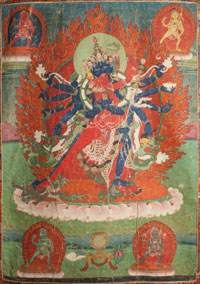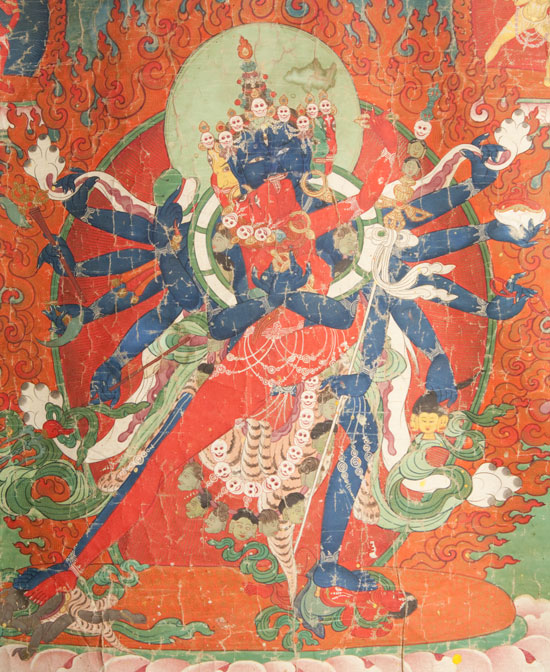mad in pursuit notebook
DISPATCHED FROM THE CROSSROADS
- home >
- favorite themes >
- art & artifacts contents >
- today's entry
Lost in the Tibetan In-Between
June 8, 2011.  It’s one of those mornings when I start out chugging my steamboat up the mighty river but wind up off in some backwater contemplating the whirlpools, marveling at the synchronicity of life and art or… whatever.
It’s one of those mornings when I start out chugging my steamboat up the mighty river but wind up off in some backwater contemplating the whirlpools, marveling at the synchronicity of life and art or… whatever.
As I listened to “Liberation Upon Hearing in the Between: Living with the Tibetan Book of the Dead,” I decided I needed to see the text and the art Thurman was clearly referring to. When I started in on the Kindle version this morning and saw the tangka* of the fierce deity Chemchok Heruka, I nearly died — we have one just like it hanging in our living room. Photo session! Resulting photo on the right with central detail below.
Of course, it turns out not to be exactly like the one in the Newark Museum, but close enough to keep me trying to learn more.

Our guy appears to be Cakrasamvara, from the Amitabha or Padma clan of Buddhas. This heruka emphasizes the subjugation of the ego through the transmutation of passion — the heat of passion is transmuted into the warmth of compassion.
His blue color symbolizes the cosmic… principle of space devoid of all qualities. Passion is the principle of the padma family, to which Cakrasamvara belongs.
He has twelve arms and four faces; the four faces are those of the other four buddha families. His main hands hold the vajra and bell signifying nonduality. His other hands hold attributes [tools] such as an elephantskin shawl (representing fearlessness), axe, hooked knife, trident, skull handdrum, a… (skull embellished trident), the head of brahma, etc.
He wears the waist garland of fifty-two heads and the tigerskin skirt of a warrior… He stands in the dance posture of a heruka — having transmuted passion into dharmic [learning] energy, he now dances with it [and in ours, copulates with the red dakini]. He wears bone and jewel ornaments. His union with his consort is the union of the intelligence and the energy aspects of the padma principle, the union of the wisdom of nirvana [enlightenment] and samsara [worldly sorrows].
He stands on Mahadeva and Umadevi, the live bodies of ego. They rest on the solar disc which represents prajna [wisdom] and the lotus of passionlessness.**
When you die, if you cannot accept the invitation of the mild Buddhas to liberation and if you then run the risk of losing control and falling under the compulsion of subconscious drives of lust and aggression and you therefore begin to panic, the Buddhas adopt a ferocious approach, forcefully breaking into your awareness and offering you a powerful escort through a realm that has suddenly become frightening. If you study the art work (such as that above) during your lifetime, you will recognize them and let them guide and protect you. [from Thurman]
Gosh.
The Rest of the Story
June 10, 2011. After I wandered into the spiritual mysteries of the Tibetan thangka, my excavatiosn surfaced the actual receipt for its purchase: from Kegan Paul, Trench, Trubner & Co. London, 1970. Jim’s note says: “collected by John Morris in Nepal or Tibet on 1st Himalayan Expedition by the British in 1924, 1st attempt to climb Everest.” Now we are perhaps in Indiana Jones territory… or at least Passion and Peril on the Silk Road territory.
I had to google the facts, of course — first discovering that the 1st British Mount Everest Expedition was not in 1924, but in 1922. And there was no John Morris on the 1924 roster. Frowning. But then, under the 1922 listing, there along with George Mallory was John Morris! Army officer, Captain C. John Morris, whose function was “translation and organisational tasks.” Grinning.
So now I want the rest of the story. The British Empire was a little infamous for taking what it pleased wherever it explored, conquered or colonized. Archaeologist Sir Aurel Stein had set an unfortunate precedent earlier in the 20th century by excavating and stripping western China of invaluable artifacts (hence the phrase “foreign devils on the Silk Road”).
On the other hand, a small expedition like this probably engaged in lots of gift exchanges. Maybe Captain Morris exchanged a pouch of tobacco for a colorful curiosity while resting up in Darjeeling. Or maybe part of his duties (esp. since he apparently spoke the language) was to specifically collect trunkloads of cultural artifacts for educational purposes… Barter or booty, we’ll probably never know — although there may be diaries, etc. that describe more than just the climbing.
Clearly this thangka (and the one purchased with it) were not in British Museum territory. Morris held on to them, perhaps until he died and his estate was sold. And Jim bought them for next to nothing at a London booksellers’ shop. And here I study it 89 years after the first Westerner laid eyes on it.
Addendum 3.9.2012
I love being public on the web. It allows sharing that might otherwise be possible, especially to this happy introvert. Months ago I posted a photo of our Chemchok Heruk tangka, followed by my discovery the the work had been acquired by mountaineer-soldier John Morris on the First British Everest Expedition with George Mallory.
My imagination soared but there seemed to be no more to learn about the adventurous collector, other than his name on the expedition list. For once, Google was silent.
But on January 29, I got an email starting with my favorite words:
As fortune would have it, I just came upon your blog and your discussion about your thangka and John Morris. I am currently researching the life and times of Charles John Morris (1895-1980), an extraordinary individual in so many ways.
And so began my correspondence with Don Johnson, anthropology lecturer at Lakehead University in Thunder Bay, Ontario. He has provided me with the following additional information on my explorer.
Yes, he took part in the 1922 Mt. Everest Exped. (as a Captain in a Gurkha Regiment he served as Transport Officer/Asst. Photographer), and also the 1936 British Everest Exped. He served in France in WWI, and later, in the 3rd Gurkha Rifles on the Northwest Frontier of India. Morris was clearly sensitive, and highly intelligent. He developed a great love for the cultures of Tibet, Sikkim, Nepal and later Japan as well. Prior to WWII he went to teach in Japan for several years. In the 1940s-1950s he worked for the BBC, most notably during the 50s as Controller for BBC 3 where he interacted with a great many writers and artists. He was a long-time friend of E.M. Forster. Morris was also a proficient and talented writer. Among his many titles is his autobiography, "Hired to Kill." [...]
As you may know, Wade Davis just published an exceptionally well-written book on the first three British expeditions to Everest entitled, "Into the Silence: The Great War, Mallory, and the Conquest of Everest." You will find a photo of Morris within, and some evocative writing about him as well. [Jan 30, 2012]
I am nearly half-way through listening to "Into the Silence," luckily in audio as well as print, which is a deep profile of the elite British Empire explorers, recovering from the damages of World War I. I ordered "Hired to Kill." An Amazon review by Art Black says the following:
John Morris (1895 - 1980) was an English adventurer, soldier, closet homesexual (until the publication of this book in 1960) and Head of the BBC's Far East Service from 1942 until 1950. In his autobiography he details his life from the earliest memories, through being pressured into a tedious bank job by his overbearing parents, and then through his military career until he was pensioned out in 1930 with tuberculosis. Morris joined the Army in 1916 mainly to escape the boredom of his job, and partly out of a sense of duty. His book is gives us a candid and often brutally honest picture of the stagnant social circles and ossified structures of the British in 1920s India. It also paints vivid pictures of his adventures, including an attempt on Everest in 1922 which included Mallory, who perished in a subjequent expedition the following year. Morris admits to his own failings, confesses to being homosexual at a time when it was far from socially acceptable, and draws us into the worlds that he passes through. Recommended to anyone who loves a good yarn, who enjoys tales of adventure, and for a snapshot into a long-gone world of the British Empire and its many characters.
Dr. Johnson further comments on Mar. 6:You will greatly enjoy "Hired to Kill" which ends when Morris is approx. 35 years. His life afterward includes another exped. to Mt. Everest (1936), obtaining a degree in Soc. Anthro. at Cambridge, fieldwork in Sikkim, teaching in Japan 1938-42, work with the BBC, writing a number of books, etc.
And so, I'm getting a much richer portrait of the man who collected a piece of art that hangs in our living room...
---
*tangka: Tibetan paintings on banners, used for teaching and meditation
**From a description of a different tangka in “Visual Dharma: The Buddhist Art of Tibet” by Chogyan Trungpa, Ripoche.

